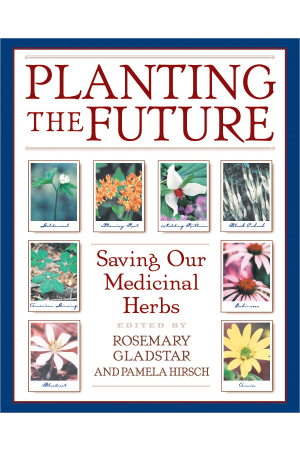- Pages: 328
- Book Size: 8 x 10
- ISBN-13: 9780892818945
- Imprint: Healing Arts Press
- On Sale Date: September 1, 2000
- Format: Paperback Book
- Illustrations: 37 color photographs
Voted one of the Top 10 books in 2000 by the Vermont Book Publishers Association.
A collective endeavor by United Plant Savers, featuring America's most respected and well-known herbalists.
Contributors include Don Babineau, Tim Blakley, Mark Blumenthal, Jane Bothwell, Stephen Harrod Buhner, David Bunting, Richo Cech, Tane Datta, Shatoiya and Rick de la Tour, Ryan Drum, Doug Elliott, Steven Foster, Cascade Anderson Geller, Kate Gilday, Rosemary Gladstar, James Green, Pamela Hirsch, Christopher Hobbs, Sara Katz, Kathi Keville, Robyn Klein, Richard Liebmann, Brigitte Mars, Pam Montgomery, Nancy and Michael Phillips, Janice J. Schofield, Joanne Marie Snow, Deb Soule, Paul Strauss, Gregory L. Tilford, Krista Thie, Susun S. Weed, David Winston, Martin Wall, Matthew Wood.
While the renaissance in the U.S. botanical market is positive in many respects, medicinal plant populations are suffering from loss of habitat and overharvesting, and many bestselling herbs are now at risk including echinacea, American ginseng, goldenseal, Hawaiian wild kava, and wild yam. The authors share their extensive experience with using and growing thirty-three of these popular herbs and include suggestions for creating your own private herbal sanctuary--whether a city balcony, suburban backyard, or rural retreat. Full-color photographs will inspire experienced and novice herb users alike to protect and cultivate these remarkable healing plants. Readers will also find out how to use herbal analogues for at-risk plants--other medicinal herbs that provide the same benefits and exist in plentiful amounts--and learn ways to make their herbal purchases a vote for sustainability. Planting the Future shows us how we can participate in the land stewardship, habitat protection, and eco-friendly consumption that will ensure an abundant, renewable supply of medicinal plants for future generations.
All author royalties will be used for replanting native medicinal herbs on a 370-acre botanical sanctuary in Ohio.
North American Indigenous Medicinal Plants
For the benefit of the plant communities, wild animals, harvesters, farmers, consumers, manufacturers, retailers, and practitioners we offer this list of wild medicinal plants that we feel are currently most sensitive to the impact of human activities. Our intent is to assure the increasing abundance of the medicinal plants that are presently in decline due to expanding popularity and shrinking habitat and range. UpS is not asking for a moratorium on the use of these herbs. Rather, we are initiating programs designed to preserve these important wild medicinal plants.
We ask wildcrafters to consider the ecological impact of taking these herbs from the wild. Replanting in the wild, as well as careful stewarding of your collection areas is of tantamount importance if the trade of wildcrafting is to continue. Although the herb may be abundant in your locality, it has probably already disappeared from other areas. Wildcrafters are among those who have the best understanding of wild plants, and you can contribute greatly by providing seed and advising others on how to plant and grow these herbs.
We ask manufacturers and consumers to assist in the transition from wildcrafted sources to those that are organically grown. If there is demand for wild herbs, then we will continue to lose them. If there is demand for cultivated herbs, then we will create environmentally friendly jobs while saving the wild plants. Although it is an expensive proposition, the time is ripe to assure sustainability of the herbs we love.
At-Risk List
American Ginseng (Panax quinquefolius)
Black Cohosh (Actaea racemosa, syn. Cimicifuga racemosa)
Bloodroot (Sanguinaria canadensis)
Blue Cohosh (Caulophyllum thalictroides)
Echinacea (Echinacea spp.)
Eyebright (Euphrasia spp.)
Goldenseal (Hydrastis canadensis)
Helonias Root (False Unicorn) (Chamaelirium luteum)
Kava, Hawaiian Wild (Piper methysticum)
Lady’s Slipper Orchid (Cypripedium spp.)
Lomatium (Lomatium dissectum)
Osha (Ligusticum porteri, L. spp.)
Peyote (Lophophora williamsii)
Slippery Elm (Ulmus rubra)
Sundew (Drosera spp.)
Trillium (Beth Root) (Trillium spp.)
True Unicorn (Aletris farinosa)
Venus’s-Flytrap (Dionaea muscipula)
Virginia Snakeroot (Aristolochia serpentaria)
Wild Yam (Dioscorea villosa, D. spp.)
To-Watch List
Arnica (Arnica spp.)
Calamus Root (Acorus calamus)
Cascara Sagrada (Rhamnus purshiana)
Chaparro (Castela emoryi)
Elephant Tree (Bursera microphylla)
Gentian (Gentiana spp.)
Goldthread (Coptis spp.)
Lobelia (Lobelia spp.)
Maidenhair Fern (Adiantum pendatum)
Mayapple (Podophyllum peltatum)
Oregon Grape (Mahonia spp.)
Partridgeberry (Mitchella repens)
Pink Root (Spigelia marilandica)
Pipsissewa (Chimaphila umbellata)
Pleurisy Root (Butterfly Weed) (Asclepias tuberosa)
Spikenard (Aralia racemosa, A.californica)
Stillingia (Queen’s Delight) (Stillingia sylvatica)
Stoneroot (Collinsonia canadensis)
Stream Orchid (Epipactis gigantea)
Turkey Corn (Dicentra canadensis)
White Sage (Salvia apiana)
Wild Indigo (Baptisia tinctoria)
Yerba Mansa (Anemopsis californica)
Yerba Santa (Eriodictyon californica)
Note: Read “spp.” as “all North American species in the genus.” We are using this category when:
(1) all North American members of the genus fit the “at risk” definition or
(2) there is reason to believe that either through inability to locate the commonly used species, or through misidentification, or through intentional collection, species besides the commonly used species in the genus might also be at risk. We see this situation clearly with the harvest of any trillium species to be sold as “bethroot,” or in the harvest of any echinacea species to be sold as “E. angustifolia.”
Acknowledgments
Foreword Richard Liebmann, N.D.
Introduction Rosemary Gladstar
What You Can Do to Make a Difference Rosemary Gladstar
Creating Botanical Sanctuaries Christopher Hobbs, L.Ac.
Wise Old Plants Robyn Klein
The American Extra Pharmacopoeia David Winston
Flower Essences Kate Gilday and Shatoiya de la Tour
Arnica Brigitte mars
Black Cohosh Richo Cech
Calamus Root Don Babineau
Cascara Sagrada Richo Cech
Echinacea Steven Foster
Eyebright Sara Katz
American Ginseng Kathi Keville
Goldenseal Mark Blumenthal
Goldthread Nancy and Michael Philips
Helonias Root Deb Soule
Kava Tane Datta
Lady's Slipper Orchid Rosemary Gladstar
Lobelia Cascade Anderson Geller
Lomatium Krista Thie
oregon Grape Ryan W. Drum, Ph.D.
Osha Gregory L. Tilford
Partridgeberry Susun S. Weed
Pipsissewa Stephen Harrod Buhner
Pleurisy Root Joanne marie Snow
Slippery Elm Paul Strauss
Spikenard Kate Gilday
Stoneroot Martin Wall
Sundew Janice J Schofield
Trillium Pamela Hirsch
Venus's-Flytrap James Green
Virginia Snakeroot Doug Elliott
Whit Sage Jane Bothwell
Wild Indigo David Bunting
American Wild yam Richo Cech
Yerba Mansa Tim Blakley
Yerba Santa Shatoiya and Rick de la Tour
Appendix 1: Sea Vegetables Ryan W. Drum, Ph.D.
Appendix 2: Concern for European Medicinal Plants Cascade Anderson Geller
Appendix 3: Planting Guides and Resources
About the Authors
Join United Plant Savers
Index
Alice Joyce, Booklist
"Exceptional."
Today's Books, February 8, 2001
"A ground-breaking book (pun intended). A manual for personal and planetary health, an important book for city and country dwellers alike."
Light of Consciousness, Winter 2002
"A must-have for all of us who say that we worship the ground we walk on."
Barbara Ardinger, PanGaia: Earthwise Spirituality, Winter 2001-02
"The book draws on the experience not only of its two editors but also many other respected herbalists from the organization United Plant Savers."
Pearly Baker Best, Magical Blend's Natural Beauty & Health, Summer 2002
FEATURING THE RESPECTED HERBALISTS OF UNITED PLANT SAVERS
Don Babineau • Tim Blakley • Mark Blumenthal • Jane Bothwell • Stephen Harrod Buhner • David Bunting • Richo Cech • Tane Datta • Shatoiya and Rick de la Tour • Ryan W. Drum • Doug Elliott • Steven Foster • Cascade Anderson Geller • Kate Gilday • Rosemary Gladstar • James Green • Pamela Hirsch • Christopher Hobbs • Sara Katz • Kathi Keville • Robyn Klein • Richard Liebmann • Brigitte Mars • Pam Montgomery • Nancy and Michael Phillips • Janice J. Schofield • Joanne Marie Snow • Deb Soule • Paul Strauss • Gregory L. Tilford • Krista Thie • Susun S. Weed • David Winston • Martin Wall • Matthew Wood
While the renaissance in the U.S. botanical market is positive in many respects, medicinal plant populations are suffering from loss of habitat and overharvesting, and many bestselling herbs are now at risk including echinacea, American ginseng, goldenseal, Hawaiian wild kava, and wild yam. The authors share their extensive experience with using and growing thirty-three of these popular herbs and include suggestions for creating your own private herbal sanctuary--whether a city balcony, suburban backyard, or rural retreat. Full-color photographs will inspire experienced and novice herb users alike to protect and cultivate these remarkable healing plants. Readers will also find out how to use herbal analogues for at-risk plants--other medicinal herbs that provide the same benefits and exist in plentiful amounts--and learn ways to make their herbal purchases a vote for sustainability. Planting the Future shows us how we can participate in the land stewardship, habitat protection, and eco-friendly consumption that will ensure an abundant, renewable supply of medicinal plants for future generations.
A practicing herbalist with twenty-six years of experience, ROSEMARY GLADSTAR is the founder of United Plant Savers (UpS), a nonprofit organization dedicated to preserving America’s native medicinal plants, and cofounder of Sage Mountain Herbs, which offers a comprehensive herbal training program. She is also the author of numerous books, including the bestselling Herbal Healing for Women. PAMELA HIRSCH, owner of Rowan Mountain Herbals, an herbal body-care business specializing in natural soaps, has worked with medicinal herbs for nearly a decade. Growing up in the Middle East, Asia, and Europe, she was exposed to different healing modalities at an early age. She shares her hard-won herbal secrets for staying healthy on the road in The Traveler’s Natural Medicine Kit (forthcoming from Healing Arts Press).







